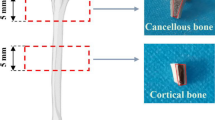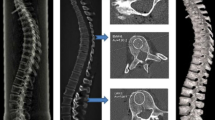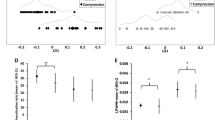Abstract
Microscopic tissue damage has been observed in otherwise healthy cancellous bone in humans and is believed to contribute to bone fragility and increased fracture risk. Animal models to study microscopic tissue damage and repair in cancellous bone would be useful, but it is currently not clear how loads applied to a whole animal bone are related to the amount and type of resulting microdamage in cancellous bone. In the current study we determine the relationship between applied cyclic compressive overloading and the resulting amount of microdamage in isolated rat tail vertebrae, a bone that has been used previously for in vivo loading experiments. Rat caudal vertebrae (C7–C9, n = 22) were potted in bone cement and subjected to cyclic compressive loading from 0 to 260 N. Loading was terminated in the secondary and tertiary phases of the creep-fatigue curve using custom data-monitoring software. In cancellous bone, trabecular microfracture was the primary form of microdamage observed with few microcracks. Trabecular microfracture prevalence increased with the amount of cyclic loading and occurred in nine out of 10 specimens loaded into the tertiary phase. Only small amounts of microdamage were observed in the cortical shell of the vertebrae, demonstrating that, under axial cyclic loading, damage occurs primarily in regions of cancellous bone before overt fracture of the bone (macroscopic cracks in the cortical shell). These experiments in isolated rat tail vertebrae suggest that it may be possible to use an animal model to study the generation and repair of microscopic tissue damage in cancellous bone.








Similar content being viewed by others
References
Frost HM (1960) Presence of microscopic cracks in vivo in bone. Bull Henry Ford Hosp 8:27–35
Norman TL, Wang Z (1997) Microdamage of human cortical bone: incidence and morphology in long bones. Bone 20:375–379
Schaffler MB, Choi K, Milgrom C (1995) Aging and matrix microdamage accumulation in human compact bone. Bone 17:521–525
Burr DB, Stafford T (1990) Validity of the bulk-staining technique to separate artifactual from in vivo bone microdamage. Clin Orthop 260:305–308
Fazzalari NL, Forwood MR, Smith K, Manthey BA, Herreen P (1998) Assessment of cancellous bone quality in severe osteoarthrosis: bone mineral density, mechanics, and microdamage. Bone 22:381–388
Wenzel TE, Schaffler MB, Fyhrie DP (1996) In vivo trabecular microcracks in human vertebral bone. Bone 19:89–95
Vashishth D, Koontz J, Qiu SJ, Lundin-Cannon D, Yeni YN, Schaffler MB, Fyhrie DP (2000) In vivo diffuse damage in human vertebral trabecular bone. Bone 26:147–152
Todd RC, Freeman MA, Pirie CJ (1972) Isolated trabecular fatigue fractures in the femoral head. J Bone Joint Surg Br 54:723–728
Vernon RB, Pirie CJ (1973) Healing trabecular microfractures in the bodies of lumbar vertebrae. Ann Rheum Dis 32:406–412
Hernandez CJ, Tang SY, Baumbach BM, Hwu PB, Sakkee AN, van der Ham F, Degroot J, Bank RA, Keaveny TM (2005) Trabecular microfracture and the influence of pyridinium and non-enzymatic glycation-mediated collagen cross-links. Bone 37:825–832
Hahn M, Vogel M, Amling M, Ritzel H, Delling G (1995) Microcallus formations of the cancellous bone: a quantitative analysis of the human spine. J Bone Miner Res 10:1410–1416
Fazzalari NL (1993) Trabecular microfracture. Calcif Tissue Int 53(Suppl 1):S143–S147
Burr D (2003) Microdamage and bone strength. Osteoporos Int 14(Suppl 5):S67–S72
Burr DB, Forwood MR, Fyhrie DP, Martin RB, Schaffler MB, Turner CH (1997) Bone microdamage and skeletal fragility in osteoporotic and stress fractures. J Bone Miner Res 12:6–15
Kopperdahl DL, Pearlman JL, Keaveny TM (2000) Biomechanical consequences of an isolated overload on the human vertebral body. J Orthop Res 18:685–690
Torrance AG, Mosley JR, Suswillo RF, Lanyon LE (1994) Noninvasive loading of the rat ulna in vivo induces a strain-related modeling response uncomplicated by trauma or periosteal pressure. Calcif Tissue Int 54:241–247
Bentolila V, Boyce TM, Fyhrie DP, Drumb R, Skerry TM, Schaffler MB (1998) Intracortical remodeling in adult rat long bones after fatigue loading. Bone 23:275–281
Uthgenannt BA, Silva MJ (2007) Use of the rat forelimb compression model to create discrete levels of bone damage in vivo. J Biomech 40:317–324
Goldstein SA, Matthews LS, Kuhn JL, Hollister SJ (1991) Trabecular bone remodeling: an experimental model. J Biomech 24(Suppl 1):135–150
van der Meulen MC, Morgan TG, Yang X, Baldini TH, Myers ER, Wright TM, Bostrom MP (2006) Cancellous bone adaptation to in vivo loading in a rabbit model. Bone 38:871–877
Waldorff EI, Goldstein SA, McCreadie BR (2007) Age-dependent microdamage removal following mechanically induced microdamage in trabecular bone in vivo. Bone 40:425–432
Chambers TJ, Evans M, Gardner TN, Turner-Smith A, Chow JW (1993) Induction of bone formation in rat tail vertebrae by mechanical loading. Bone Miner 20:167–178
Burr DB, Hooser M (1995) Alterations to the en bloc basic fuchsin staining protocol for the demonstration of microdamage produced in vivo. Bone 17:431–433
Eswaran SK, Gupta A, Adams MF, Keaveny TM (2006) Cortical and trabecular load sharing in the human vertebral body. J Bone Miner Res 21:307–314
Kim CH, Takai E, Culella N, Guo XE (2002) Measurements of in vivo strains in the rat tail vertebra. In: Proceedings of ASME international mechanical engineering congress & exposition, IMECE 2002-32597
Guo XE, Eichler MJ, Takai E, Kim CH (2002) Quantification of a rat tail vertebra model for trabecular bone adaptation studies. J Biomech 35:363–368
De Souza RL, Matsuura M, Eckstein F, Rawlinson SC, Lanyon LE, Pitsillides AA (2005) Non-invasive axial loading of mouse tibiae increases cortical bone formation and modifies trabecular organization: a new model to study cortical and cancellous compartments in a single loaded element. Bone 37:810–818
Fritton JC, Myers ER, Wright TM, van der Meulen MC (2005) Loading induces site-specific increases in mineral content assessed by microcomputed tomography of the mouse tibia. Bone 36:1030–1038
Acknowledgements
This work was supported by the Case Western Reserve University Presidential Research Initiative. The authors thank Drs. David Burr and Matthew Allen for advice on microdamage characterization.
Author information
Authors and Affiliations
Corresponding author
Rights and permissions
About this article
Cite this article
Kummari, S.R., Davis, A.J., Vega, L.A. et al. Trabecular Microfracture Precedes Cortical Shell Failure in the Rat Caudal Vertebra Under Cyclic Overloading. Calcif Tissue Int 85, 127–133 (2009). https://doi.org/10.1007/s00223-009-9257-3
Received:
Accepted:
Published:
Issue Date:
DOI: https://doi.org/10.1007/s00223-009-9257-3




